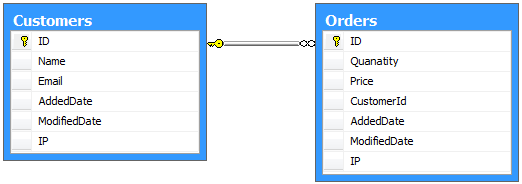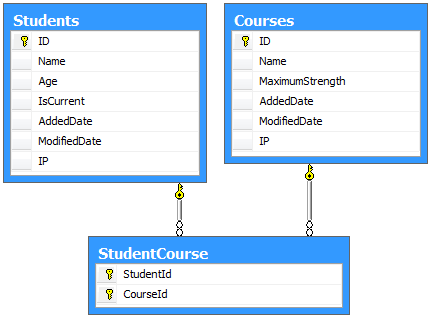一.One-to-One Relationship【一对一关系】
两个表之间,只能由一个记录在另外一个表中。每一个主键的值,只能关联到另外一张表的一条或者零条记录。请记住,这个一对一的关系不是非常的普遍,并且大多数的一对一的关系,是商业逻辑使然,并且数据也不是自然地。缺乏这样一条规则,就是在这种关系下,你可以把两个表合并为一个表,而不打破正常化的规则。
为了理解一对一关系,我们创建两个实体,一个是User另外一个是UserProfile,一个User只有单个Profile,User表将会有一个主键,并且这个字段将会是UserProfile表的主键和外键。我们看下图:

创建两个实体,一个是User实体,另外一个是UserProfile实体。我们的User实体的代码如下:
using System;
using System.Collections.Generic;
using System.Linq;
using System.Text;
using System.Threading.Tasks;
namespace EF.Core.Data
{
public class User:BaseEntity
{
/// <summary>
/// 用户名
/// </summary>
public string UserName { get; set; }
/// <summary>
/// 电子邮件
/// </summary>
public string Email { get; set; }
/// <summary>
/// 密码
/// </summary>
public string Password { get; set; }
/// <summary>
/// 导航属性--用户详情
/// </summary>
public virtual UserProfile UserProfile { get; set; }
}
}
UserProfile实体的代码快如下:
using System;
using System.Collections.Generic;
using System.Linq;
using System.Text;
namespace EF.Core.Data
{
/// <summary>
/// 用户详情实体
/// </summary>
public class UserProfile:BaseEntity
{
/// <summary>
/// 姓
/// </summary>
public string FirstName { get; set; }
/// <summary>
/// 名
/// </summary>
public string LastName { get; set; }
/// <summary>
/// 地址
/// </summary>
public string Address { get; set; }
/// <summary>
/// 导航属性--User
/// </summary>
public virtual User User { get; set; }
}
}
就像你看到的一样,上面的两个部分的代码块中,每个实体都使用彼此的实体,作为导航属性,因此你可以从任何实体中访问另外的实体。
使用Fluent Api配置Users实体:
using EF.Core.Data;
using System;
using System.Collections.Generic;
using System.ComponentModel.DataAnnotations.Schema;
using System.Data.Entity.ModelConfiguration;
using System.Linq;
using System.Text;
using System.Threading.Tasks;
namespace EF.Data.Mapping
{
public class UserMap:EntityTypeConfiguration<User>
{
public UserMap()
{
//配置主键
this.HasKey(s => s.ID);
//给ID配置自动增长
this.Property(s => s.ID).HasDatabaseGeneratedOption(DatabaseGeneratedOption.Identity);
//配置字段
this.Property(s => s.UserName).IsRequired().HasColumnType("nvarchar").HasMaxLength(25);
this.Property(s => s.Email).IsRequired().HasColumnType("nvarchar").HasMaxLength(25);
this.Property(s => s.AddedDate).IsRequired();
this.Property(s => s.ModifiedDate).IsRequired();
this.Property(s => s.IP);
//配置表
this.ToTable("User");
}
}
}
使用Fluent Api配置UserProfile实体
using EF.Core.Data;
using System;
using System.Collections.Generic;
using System.Data.Entity.ModelConfiguration;
using System.Linq;
using System.Text;
using System.Threading.Tasks;
namespace EF.Data.Mapping
{
public class UserProfileMap:EntityTypeConfiguration<UserProfile>
{
public UserProfileMap()
{
this.HasKey(s=>s.ID);
this.Property(s => s.FirstName).IsRequired();
this.Property(s => s.LastName).IsRequired();
this.Property(s => s.Address).HasMaxLength(100).HasColumnType("nvarchar").IsRequired();
this.Property(s => s.AddedDate).IsRequired();
this.Property(s => s.ModifiedDate).IsRequired();
this.Property(s => s.IP);
//配置关系[一个用户只能有一个用户详情!!!]
this.HasRequired(s => s.User).WithRequiredDependent(s => s.UserProfile);
this.ToTable("UserProfile");
}
}
}
现在,我们创建一个数据库上下文类EFDbContext,这个类继承DbContext类,在这个数据库上下文类中,我们重写OnModelCreating方法,这个OnModelCreating方法,在数据库上下文(EFDbContext)已经初始化的完成的时候,被调用,在OnModelCreating方法中,我们使用了反射,来为每个实体生成配置类。
using System;
using System.Collections.Generic;
using System.Data.Entity;
using System.Data.Entity.ModelConfiguration;
using System.Linq;
using System.Reflection;
using System.Text;
using System.Threading.Tasks;
namespace EF.Data
{
public class EFDbContext:DbContext
{
public EFDbContext()
: base("name=DbConnectionString")
{
}
protected override void OnModelCreating(DbModelBuilder modelBuilder)
{
{
var typesToRegister = Assembly.GetExecutingAssembly().GetTypes()
.Where(type => !String.IsNullOrEmpty(type.Namespace))
.Where(type => type.BaseType != null && type.BaseType.IsGenericType
&& type.BaseType.GetGenericTypeDefinition() == typeof(EntityTypeConfiguration<>));
foreach (var type in typesToRegister)
{
dynamic configurationInstance = Activator.CreateInstance(type);
modelBuilder.Configurations.Add(configurationInstance);
}
base.OnModelCreating(modelBuilder);
}
}
}
}
二.One-to-Many Relationship【一对多关系】
主键表的一个记录,关联到关联表中,存在,没有,或者有一个,或者多个记录。这是最重要的也是最常见的关系
为了更好的理解一对多的关系,可以联想到电子商务系统中,单个用户可以下很多订单,所以我们定义了两个实体,一个是客户实体,另外一个是订单实体。我们看看下面的图片:

实体Customers代码:
using System;
using System.Collections.Generic;
using System.Linq;
using System.Text;
using System.Threading.Tasks;
namespace EF.Core.Data
{
public class Customer:BaseEntity
{
/// <summary>
/// 客户名称
/// </summary>
public string Name { get; set; }
/// <summary>
/// 客户电子邮件
/// </summary>
public string Emial { get; set; }
/// <summary>
/// 导航属性--Order
/// </summary>
public virtual ICollection<Order> Orders { get; set; }
}
}
实体Orders代码:
using System;
using System.Collections.Generic;
using System.Linq;
using System.Text;
namespace EF.Core.Data
{
public class Order:BaseEntity
{
/// <summary>
/// 数量
/// </summary>
public byte Quantity { get; set; }
/// <summary>
/// 价格
/// </summary>
public decimal Price { get; set; }
/// <summary>
/// 客户ID
/// </summary>
public int CustomerId { get; set; }
/// <summary>
/// 导航属性--Customer
/// </summary>
public virtual Customer Customer { get; set; }
}
}
你已经在上面的代码中注意到了导航属性,Customer实体有一个集合类型的Order属性,Order实体有一个Customer实体的导航属性,也就是说,一个客户可以有很多订单。
使用Fluent Api配置Customer实体
using EF.Core.Data;
using System;
using System.Collections.Generic;
using System.ComponentModel.DataAnnotations.Schema;
using System.Data.Entity.ModelConfiguration;
using System.Linq;
using System.Text;
using System.Threading.Tasks;
namespace EF.Data.Mapping
{
public class CustomerMap:EntityTypeConfiguration<Customer>
{
public CustomerMap()
{
this.HasKey(s => s.ID);
//properties
Property(t => t.ID).HasDatabaseGeneratedOption(DatabaseGeneratedOption.Identity);
Property(t => t.Name);
Property(t => t.Email).IsRequired();
Property(t => t.AddedDate).IsRequired();
Property(t => t.ModifiedDate).IsRequired();
Property(t => t.IP);
//table
ToTable("Customers");
}
}
}
使用Fluent Api配置Orders实体
using EF.Core.Data;
using System;
using System.Collections.Generic;
using System.ComponentModel.DataAnnotations.Schema;
using System.Data.Entity.ModelConfiguration;
using System.Linq;
using System.Text;
using System.Threading.Tasks;
namespace EF.Data.Mapping
{
public class OrderMap:EntityTypeConfiguration<Order>
{
public OrderMap()
{
this.HasKey(s=>s.ID);
//fields
Property(t => t.ID).HasDatabaseGeneratedOption(DatabaseGeneratedOption.Identity);
Property(t => t.Quanatity).IsRequired().HasColumnType("tinyint");
Property(t => t.Price).IsRequired();
Property(t => t.CustomerId).IsRequired();
Property(t => t.AddedDate).IsRequired();
Property(t => t.ModifiedDate).IsRequired();
Property(t => t.IP);
//配置关系【一个用户有多个订单,外键是CusyomerId】
this.HasRequired(s => s.Customer).WithMany(s => s.Orders).HasForeignKey(s => s.CustomerId).WillCascadeOnDelete(true);
//table
ToTable("Orders");
}
}
}
上面的代码表示:用户在每个Order中是必须的,并且用户可以下多个订单,两个表之间通过外键CustomerId联系,我们使用了四个方法来定义实体之间的关系,Withmany方法允许多个。HasForeignKey方法表示哪个属性是Order表的外键,WillCascadeOnDelete方法用来配置是否级联删除。
三.Many-to-Many Relationship【多对多关系】
每条记录在两个表中,都可以关联到另外一个表中的很多记录【或者0条记录】。多对多关系,需要第三方的表,也就是关联表或者链接表,因为关系型数据库不能直接适应这种关系。
为了更好的理解多对多关系,我们想到,有一个选课系统,一个学生可以选秀很多课程,一个课程能够被很多学生选修,所以我们定义两个实体,一个是Syudent实体,另外一个是Course实体。我们来通过图表看看,多对多关系吧:

Student实体
using System;
using System.Collections.Generic;
using System.Linq;
using System.Text;
using System.Threading.Tasks;
namespace EF.Core.Data
{
public class Student:BaseEntity
{
public string Name { get; set; }
public byte Age { get; set; }
public bool IsCurrent { get; set; }
public virtual ICollection<Course> Courses { get; set; }
}
}
Courses实体
using System;
using System.Collections.Generic;
using System.Linq;
using System.Text;
namespace EF.Core.Data
{
public class Course:BaseEntity
{
public string Name { get; set; }
public Int64 MaximumStrength { get; set; }
public virtual ICollection<Student> Students { get; set; }
}
}
使用Fluent Api配置Student实体
using EF.Core.Data;
using System;
using System.Collections.Generic;
using System.ComponentModel.DataAnnotations.Schema;
using System.Data.Entity.ModelConfiguration;
using System.Linq;
using System.Text;
using System.Threading.Tasks;
namespace EF.Data.Mapping
{
public class StudentMap:EntityTypeConfiguration<Student>
{
public StudentMap()
{
//key
HasKey(t => t.ID);
//property
Property(t => t.ID).HasDatabaseGeneratedOption(DatabaseGeneratedOption.Identity);
Property(t => t.Name);
Property(t => t.Age);
Property(t => t.IsCurrent);
Property(t => t.AddedDate).IsRequired();
Property(t => t.ModifiedDate).IsRequired();
Property(t => t.IP);
//table
ToTable("Students");
//配置关系[多个课程,可以被多个学生选修]
//多对多关系实现要领:hasmany,hasmany,然后映射生成第三个表,最后映射leftkey,rightkey
this.HasMany(s => s.Courses).
WithMany(s => s.Students)
.Map(s => s.ToTable("StudentCourse").
MapLeftKey("StudentId").
MapRightKey("CourseId"));
}
}
}
上面的代码中,表示,一个学生可以选修多个课程,并且每个课程可以有很多学生,你知道,实现多对多的关系,我们需要第三个表,所以我们映射了第三个表,mapLeftkey和maprightkey定义了第三个表中的键,如果我们不指定的话,就会按照约定生成类名_Id的键。
使用Fluent Api配置Courses实体
using EF.Core.Data;
using System;
using System.Collections.Generic;
using System.ComponentModel.DataAnnotations.Schema;
using System.Data.Entity.ModelConfiguration;
using System.Linq;
using System.Text;
using System.Threading.Tasks;
namespace EF.Data.Mapping
{
public class CourseMap:EntityTypeConfiguration<Course>
{
public CourseMap()
{
this.HasKey(t => t.ID);//少了一行代码
//property
Property(t => t.ID).HasDatabaseGeneratedOption(DatabaseGeneratedOption.Identity);
Property(t => t.Name);
Property(t => t.MaximumStrength);
Property(t => t.AddedDate).IsRequired();
Property(t => t.ModifiedDate).IsRequired();
Property(t => t.IP);
//table
ToTable("Courses");
}
}
}
出处:https://www.cnblogs.com/caofangsheng/p/5715876.html